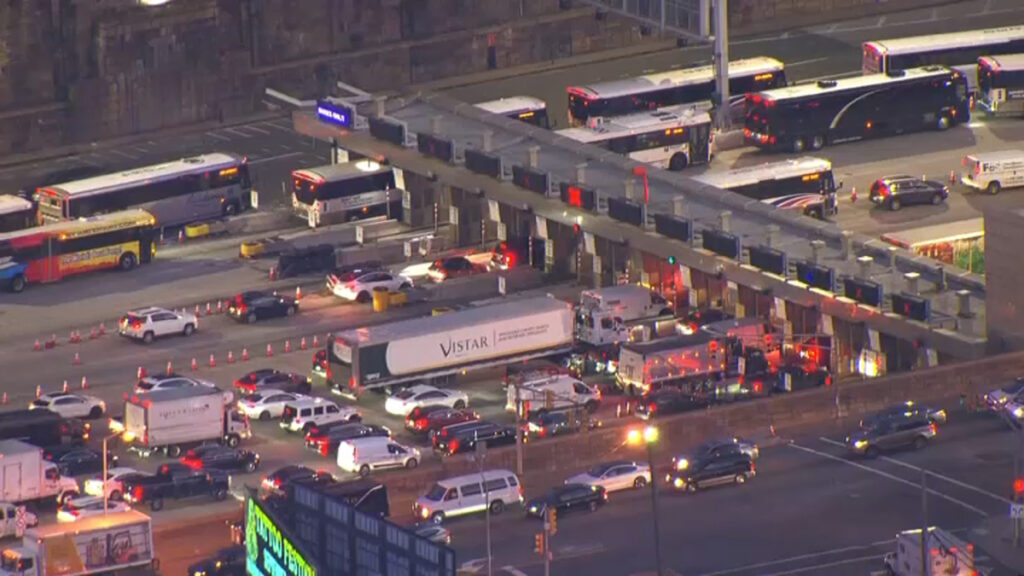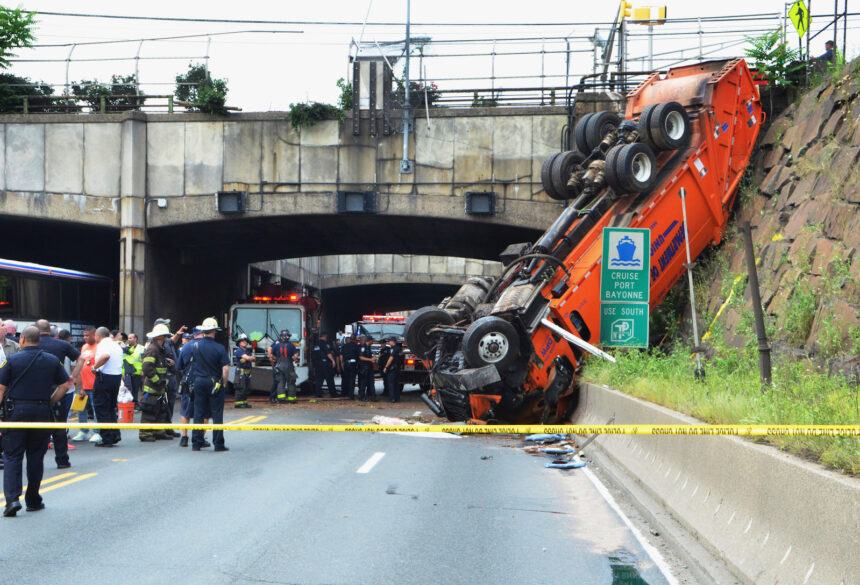On an already chaotic Tuesday morning, New York City commuters faced a nightmare scenario involving extensive delays, traffic snarls, and even broken-down buses, all sparked by a series of accidents in the Lincoln Tunnel. This critical tunnel connecting New Jersey and Manhattan, an artery for thousands of daily commuters, became the epicenter of frustration, confusion, and gridlock. The cascading effects of these incidents spilled onto surrounding highways, NJ Transit systems, and into the streets of Manhattan, already impacted by the United Nations General Assembly’s street closures on the East Side.
An Unfortunate Chain of Events
The calamity began at around 3:50 a.m. when a motorcycle crash in the center tube of the Lincoln Tunnel set the stage for what would become an unrelenting day of traffic nightmares. According to the Port Authority of New York and New Jersey, the motorcyclist, critically injured, was rushed to the hospital. The crash necessitated the closure of the center tube for several hours as authorities investigated and cleared the scene. Traffic quickly began to pile up, with commuters finding themselves in hour-long delays that stretched back to key access points like the New Jersey Turnpike and Route 3.
As if the motorcycle accident wasn’t disruptive enough, just before 7 a.m., another incident added to the growing mess. A bus broke down in the tunnel, worsening the already dire situation. With the center tube closed and the north tube still undergoing construction, the few routes into New York City were quickly overwhelmed. The Port Authority had no choice but to wrap up the construction early and open the north tube to alleviate some of the pressure. But by then, the damage had been done.
At its worst, delays stretched up to 90 minutes, with gridlock extending not only through the Lincoln Tunnel but also impacting the George Washington Bridge and other crossings into Manhattan. For many commuters, it was a day they’d rather forget.
An Overwhelmed Transit System
The ripple effect of the Lincoln Tunnel accidents wasn’t limited to the tunnel itself. The entire NJ Transit system buckled under the pressure as bus routes faced delays of over an hour. NJ Transit was forced to issue a statement that buses traveling into New York City were facing up to 60-minute delays, leaving many commuters stranded or severely delayed.
The frustrations of commuters were palpable. Some bus riders, fed up with waiting in endless lines of traffic, abandoned their vehicles and opted to walk alongside the New Jersey Turnpike. Video footage captured these scenes, a testament to the sheer chaos that had unfolded.
NJ Transit also cross-honored bus tickets on its rail and PATH lines, allowing stranded passengers to seek alternate ways into the city. However, rail lines weren’t immune to the day’s challenges either. At around 9:45 a.m., service was suspended in and out of Penn Station due to a power issue at a substation, compounding an already disastrous morning. Though the issue was resolved within the hour, many passengers were left waiting, missing appointments, and in some cases, simply giving up on the day’s commute altogether.
One frustrated commuter, Rabbi Gaon Gilad, shared his experience, lamenting the fact that his train, which was supposed to arrive at Penn Station at 9:40 a.m., was still stuck at 11:15 a.m. “I missed my classes. I teach in the Upper East Side. My school now, they’re all scrambling, trying to find last-minute substitutions,” he said. Stories like his became commonplace as the delays stretched on.
The UNGA Effect: A Perfect Storm of Traffic Woes
To make matters worse, Tuesday marked the first day of street closures for the United Nations General Assembly (UNGA), further choking off key parts of Manhattan’s already congested streets. Held annually in New York City, the UNGA is infamous for causing gridlock as world leaders descend on the city. This year, the assembly’s High-Level Debate, scheduled to take place from September 24 to 28, meant additional security measures and closures were implemented across Manhattan’s East Side.
The NYPD announced that streets from East 34th Street to East 63rd Street along 1st Avenue, as well as large portions of the FDR Drive, would be closed intermittently through September 30. In combination with the Lincoln Tunnel delays, it created the perfect storm for drivers attempting to navigate the city.
One commuter shared their frustration: “It’s life in New York City. You just have to expect it, especially in September when everything seems to happen at once.” Another driver echoed similar sentiments, saying, “Wish I didn’t have to deal with it, but it happens.”
These closures led to a considerable amount of diverted traffic that would normally flow smoothly through Midtown. Emergency services were put on high alert, and additional NYPD traffic units were deployed to help manage the overflow, though even their best efforts were insufficient to tame the gridlock that spread through the borough.
Lincoln Tunnel’s Critical Role in NYC’s Transportation Network
We want you to have the best commute no matter who it's with and this morning that is not on Boxcar. The Port Authority has announced it due to a major crash in investigation there are 90 minute delays at the Lincoln tunnel. We've never seen this before.
We are diverting all… pic.twitter.com/CwsiQsnZ6u
— Boxcar (@boxcartransit) September 10, 2024The Lincoln Tunnel, one of the three main vehicular crossings into Manhattan, is no stranger to traffic disruptions. Opened in 1937, it now handles around 120,000 vehicles per day, making it one of the busiest tunnels in the world. But this critical link between New Jersey and New York City often suffers from delays, largely due to its age and the ever-increasing number of commuters who rely on it daily.
The tunnel features three tubes: a south tube, a center tube, and a north tube. Normally, all three are operational, with the center tube serving as a bidirectional passage depending on traffic flow. On Tuesday, however, with the center tube shut down due to the motorcycle accident and ongoing construction in the north tube, the tunnel’s capacity was significantly reduced.
The closure of even a single tube can cause hours-long delays, as drivers have few alternative routes. The Holland Tunnel, another major link between New Jersey and Lower Manhattan, quickly became overwhelmed as drivers sought a way into the city, leading to delays there as well.
The George Washington Bridge, connecting Fort Lee, New Jersey, to Upper Manhattan, also saw increased traffic volume. At one point, delays approaching the bridge were reported to be over an hour, exacerbating the morning commute nightmare for drivers in all directions.
Commuter Struggles: Real Stories from the Ground
Lincoln tunnel apparently shut down. So the buses are fucked, the ferry is now fucked (everyone is being directed to the ferry) and my commute into NYC this morning is a hellhole shitshow. pic.twitter.com/6lVwpG8YAu
— Stephanie Joyce (@Ciel_Rouge) September 10, 2024Commuters caught in the Lincoln Tunnel gridlock shared their stories of frustration. Nina Rappaport, one of the countless individuals impacted, spoke of her disbelief at the recurring issues. “We thought all these problems had been solved this summer, because there were so many issues then. But I guess it turned out not,” she said.
Another commuter, Abigail Amengual, voiced her frustration with the recurring delays. “I feel like it’s something that they should be able to get under control by now. It’s 2024, and this still happens way too often.”
For others, the day’s commute was so bad that they had no choice but to give up. “I officially spent two hours on a bus from Hackensack to NYC—a trip that usually takes 35 to 40 minutes. And I wasn’t even on the road into the tunnel yet,” one exasperated rider wrote on X, formerly known as Twitter. The situation was so severe that many riders simply abandoned their buses and walked alongside the New Jersey Turnpike in the direction of Paterson Plank Road, heading to Secaucus in an attempt to bypass the chaos.
The Road to Recovery
By 9:15 a.m., Port Authority officials announced that the Lincoln Tunnel’s center tube had reopened, but for many commuters, the damage had already been done. Traffic backups persisted for hours, and NJ Transit struggled to restore service to pre-crash levels. Amtrak, similarly affected by the morning’s disruptions, worked to resolve the power issues that had stalled trains into and out of Penn Station.
Though normal service resumed on NJ Transit rail lines and buses by mid-afternoon, the ordeal left a sour taste in the mouths of many commuters who had been caught up in the mayhem. By 1 p.m., NJ Transit declared that trains were back on schedule, but for those who had been significantly delayed, the sense of frustration lingered.
Looking Forward: Can These Problems Be Prevented?
The events of that chaotic Tuesday raise significant questions about New York City’s transportation infrastructure. With the city’s reliance on a handful of key tunnels and bridges, any major incident can trigger massive ripple effects that bring the entire system to a halt. As the region continues to grow, the pressure on these aging systems increases. In the case of the Lincoln Tunnel, the combination of a motorcycle crash, a broken-down bus, and ongoing construction led to a cascading failure that impacted tens of thousands of commuters.
Some have called for renewed investment in transportation infrastructure, noting that the tunnel, opened over 80 years ago, is overdue for upgrades. Others have suggested more proactive traffic management solutions, such as real-time rerouting and better communication with commuters to prevent the kind of confusion and chaos seen on Tuesday.
The UNGA’s impact on Manhattan’s traffic only highlighted how easily the city can become gridlocked during high-stakes events. With world leaders in town, security concerns often take priority, but that doesn’t mean the city can’t do more to mitigate the impact on local commuters.
Conclusion: A Day of Unforeseen Challenges

For many, Tuesday’s commute was a vivid reminder of the fragility of New York City’s transit systems. The chain of events in the Lincoln Tunnel, combined with ongoing street closures for the UNGA, created a perfect storm of delays, frustrations, and missed appointments. While the center tube eventually reopened and NJ Transit resumed normal service, the day’s chaos serves as a sobering lesson in the vulnerabilities of the region’s transportation network.
As the city looks to the future, commuters are left wondering if the lessons learned from this incident will prompt meaningful change—or if this will simply be another chapter in New York City’s long history of transportation struggles.





